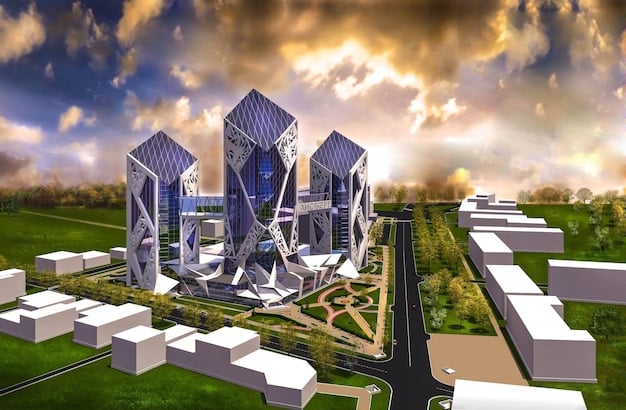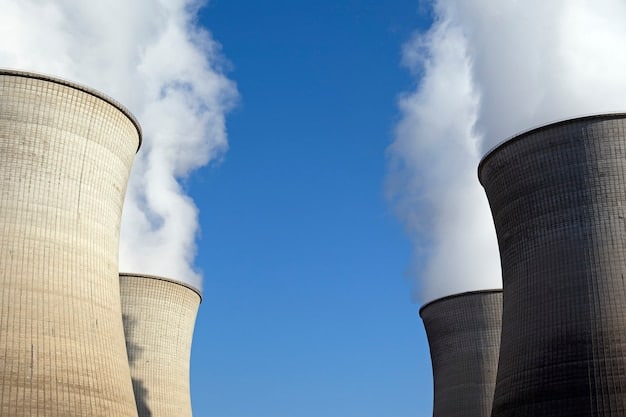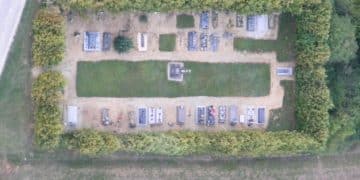Carbon Capture Advancements: Reducing US Emissions by 2030

Carbon capture technology is rapidly advancing, offering increasingly effective methods to reduce greenhouse gas emissions in the US by 2030 through innovations like direct air capture, enhanced mineralization, and improved storage techniques.
What are the **latest advancements in carbon capture technology and their potential to reduce US greenhouse gas emissions by 2030**? The answer lies in groundbreaking innovations transforming industries.
Climate Change Mitigation
**Reducing carbon emissions** is crucial for mitigating climate change. The United States has set ambitious goals for reducing greenhouse gas emissions in the coming years, and **carbon capture technology** can play a vital role in achieving these targets. This technology involves capturing carbon dioxide (CO2) from emission sources, such as power plants and industrial facilities, or directly from the atmosphere, and then storing it permanently underground or utilizing it in various industrial processes.

Innovation in Carbon Capture Methods
The past decade has seen remarkable advancements in carbon capture technology. These innovations have significantly improved efficiency, reduced costs, and expanded the range of applications. Here are some pivotal areas where carbon capture technology has made significant strides:
### Direct Air Capture (DAC)
**Direct Air Capture** is capturing CO2 directly from the ambient air. DAC represents a revolutionary approach. Unlike traditional carbon capture methods that target emission sources, DAC systems can be deployed anywhere, which makes them particularly suitable for addressing dispersed emissions.
### Mineralization
Mineralization is a method where captured CO2 reacts with certain minerals to produce stable carbonates. These carbonates can then be used in construction materials, providing a permanent and safe way to store carbon.
### Enhanced Utilization Techniques
Enhanced Utilization Techniques are focusing on converting captured CO2 into valuable products. CO2 can be used as a feedstock to produce fuels, plastics, and other chemicals, creating economic incentives for carbon capture.
Some Key points about Carbon Capture:
* **Efficiency Improvements:** Modern carbon capture systems are more efficient, capturing over 90% of the CO2 emissions from targeted sources.
* **Cost Reduction:** The cost of carbon capture is steadily declining due to technological advancements.
* **Scalability:** Many recent innovations are designed for scalability.
As carbon capture technologies evolve, it’s important to consider their potential to reshape our approach to climate action. Each method offers unique benefits and challenges, informing strategic decisions for investment and deployment.
**In conclusion**, the progress in carbon capture technologies signifies a critical opportunity to enhance our strategies. Further research and development will refine these processes, strengthening their ability to reduce emissions and contribute to environmental sustainability.

Potential to Reduce US Greenhouse Gas Emissions by 2030
The potential for **carbon capture** to significantly reduce US greenhouse gas emissions by 2030 is substantial, provided that the technology is deployed effectively and at scale. Several factors influence the extent of this potential, including technological readiness, policy support, and economic viability.
### Infrastructure Development
Infrastructure development is critical for the widespread adoption of carbon capture. A well-established network for transporting and storing captured CO2 is essential for realizing the technology’s full potential.
### Policy Incentives
Policy incentives, such as tax credits and carbon pricing mechanisms, can create a favorable environment for carbon capture deployment. These incentives encourage private sector investment and innovation in carbon capture technologies.
### Public-Private Partnerships
Public-Private Partnerships can accelerate the development and deployment of carbon capture projects. By combining government funding with private sector expertise, these partnerships can help overcome technical and financial barriers.
Key considerations for achieving emission reduction goals include:
* **Strategic Deployment:** Focusing on high-emission sources and regions where carbon capture is most effective.
* **Optimizing Storage:** Developing secure and cost-effective CO2 storage solutions.
* **Long-Term Planning:** Ensuring sustained investment and support for carbon capture technologies.
The impact of **carbon capture on US emissions** will largely depend on strategic deployment, proactive policy-making, and a cooperative approach across sectors. As these technologies continue to develop, integrating them into the broader strategy for reducing greenhouse gas emissions is crucial.
In summary, the potential of **carbon capture technology** to cut US greenhouse gas emissions by 2030 is significantly affected by how well infrastructure is developed, incentives are created, and collaborations are formed. With focused strategies and continued support, carbon capture can substantially help in achieving environmental objectives.
Innovative Carbon Capture Projects in the US
Several innovative **carbon capture** projects are underway in the US, demonstrating the technology’s versatility and potential. These projects span various sectors, including power generation, industrial manufacturing, and direct air capture.
### Petra Nova Project
The Petra Nova Project showcases the application of carbon capture in the power generation sector. This project, located in Texas, is designed to capture CO2 from a coal-fired power plant and use it for enhanced oil recovery.
### Illinois Industrial Carbon Capture Project
The Illinois Industrial Carbon Capture Project focuses on capturing CO2 from an ethanol production facility and storing it underground. This project highlights the potential for carbon capture in the biofuels industry.
### Global Thermostat Project
The Global Thermostat Project is an example of direct air capture technology being deployed in the US. This project aims to capture CO2 directly from the atmosphere and use it for various applications.
Important components of effective carbon capture utilization:
* **Comprehensive analysis** is necessary to determine ideal technologies and practices.
* **Effective strategies** can significantly improve the efficiency of carbon capture practices.
* **Careful data monitoring** helps optimize utilization and minimize waste.
These projects showcase practical applications of **carbon capture technology** across different fields, underlining its potential in reducing emissions. As these innovations advance, their lessons can inform further deployments and optimize processes on a larger scale.
In closing, innovative carbon capture projects in the US highlight the practical, versatile application of this technology. Their ongoing development and success provide valuable insights for broader adoption and enhancement of carbon reduction strategies across the nation.
Challenges and Opportunities in Carbon Capture Development
Despite significant advancements, **carbon capture** technology faces several challenges that need to be addressed to realize its full potential. These challenges include high costs, energy requirements, and public acceptance.
### Cost Reduction Strategies
Cost reduction strategies are essential for making carbon capture economically viable. Innovative approaches, such as modular designs and improved solvents, can help lower the capital and operating costs of carbon capture systems.
### Energy Efficiency Improvements
Energy Efficiency Improvements are needed to reduce the energy penalty associated with carbon capture. Developing more efficient capture processes and integrating them with renewable energy sources can minimize the energy footprint of carbon capture.
### Public Engagement
Public Engagement is critical for building support for carbon capture projects. Engaging with local communities and addressing their concerns can help overcome public resistance and facilitate the deployment of carbon capture infrastructure.
Effective strategies to develop carbon capture technology:
* **Optimized resource use** ensures sustainability and maximizes extraction efficiency.
* **Innovative technologies** can significantly reduce costs.
* **Environmental benefits** should always be clearly communicated.
**Carbon capture** technology requires facing several key challenges for extensive progress. Tackling problems such as costs, energy usage, and ensuring public agreement is vital for making the technology effective. Overcoming these challenges offers opportunities for future growth, contributing to effective emissions reduction.
Therefore, addressing these challenges is critical for unlocking the full potential of carbon capture and achieving significant greenhouse gas emission reductions.
The Role of Government and Private Sector Investment
Government and private sector investment play a crucial role in advancing **carbon capture** technology. Government funding supports research and development, while private sector investment drives the commercialization and deployment of carbon capture solutions.
### Government Incentives
Government Incentives such as tax credits, grants, and loan guarantees, can stimulate private sector investment in carbon capture projects. These incentives help reduce the financial risks associated with deploying new technologies.
### Research and Development Funding
Research and Development Funding is essential for advancing carbon capture technologies. Government agencies and private foundations can support research efforts aimed at improving the efficiency, reducing the cost, and expanding the applications of carbon capture.
### Collaboration
Collaboration between government, industry, and academia can accelerate the development and deployment of carbon capture technologies. By sharing knowledge, resources, and expertise, these collaborations can help overcome technical and financial barriers.
Key focal point of government and private sector investment:
* **Private investments** are necessary for deployment and scalability.
* **Government investments** can significantly enhance research capabilities.
* **Policy frameworks** can help encourage investment and adoption.
The growth and success of **carbon capture** depend greatly on the combined support from government and private sectors. While governmental investments fuel necessary research, the private sector makes developments commercially viable. It is important to establish supportive policies and collaborative environments that encourage continued investment and progress in carbon capture technologies.
The future of Carbon Capture in the US
The future of **carbon capture** in the US looks promising, with continued innovation, policy support, and investment paving the way for widespread deployment. As carbon capture technologies mature, they are expected to play an increasingly important role in mitigating climate change and achieving the nation’s emission reduction goals.
### Technology Advancements
Technology Advancements are expected to further improve the efficiency, reduce the cost, and expand the applications of carbon capture. Innovations in capture materials, process designs, and utilization techniques are likely to drive down the cost of carbon capture and make it more competitive with other emission reduction strategies.
### Policy Support
Policy Support is expected to continue to play a vital role in driving the deployment of carbon capture. Supportive policies, such as the 45Q tax credit, can provide financial incentives for carbon capture projects and encourage private sector investment.
### Market Growth
Market Growth for carbon capture technologies is expected to accelerate as companies and governments increasingly prioritize carbon reduction. The demand for carbon capture solutions is likely to grow as more countries and regions adopt ambitious climate targets and implement carbon pricing mechanisms.
The most important considerations for the future:
* **Long-term visions** are essential for strategic planning of sustainable energy solutions.
* **Continuous support** to facilitate ongoing advances.
* **Integration of sustainability measures** can transform industrial practices.
For **carbon capture** to have a long lasting future in the US, it depends on consistent innovative breakthroughs, supportive policies, and increased market demand. Sustained progress in technology, positive policy frameworks, and market growth are vital in ensuring carbon capture significantly helps in achieving emission reduction goals.
To summarise, the future of carbon capture in the US holds significant promise, dependent on continued support to promote industry growth, and the incorporation of sustainable measures. These actions support the role of the technology in achieving emission reduction goals.
| Key Aspect | Brief Description |
|---|---|
| 🌱 Advancements in DAC | Direct air capture is removing CO2 directly from the atmosphere, applicable anywhere. |
| 💰 Cost Reduction Strategies | Implementing innovative designs and solvents to reduce the high costs of carbon capture. |
| 🤝 Public-Private Partnerships | Combining government support with private expertise to accelerate project development. |
| 📈 Government Incentives | Tax credits and grants to encourage private sector investments in carbon capture. |
How effective is carbon capture technology?
How effective is carbon capture technology?
What are the best methods for storing captured carbon dioxide?
What are the best methods for storing captured carbon dioxide?
What role do governmental policies play in carbon capture?
What role do governmental policies play in carbon capture?
How does carbon capture affect industries?
How does carbon capture affect industries?
What are the future trends in carbon capture technology?
What are the future trends in carbon capture technology?
Climate change mitigation is a global concern, and reducing our collective carbon footprint is essential. Understanding the **latest advancements in carbon capture technology and their potential to reduce US greenhouse gas emissions by 2030** is crucial for informed decisions and effective action. As these technologies mature and become more cost-effective, they can significantly contribute to a more sustainable future.





